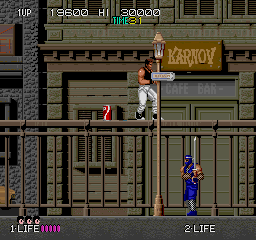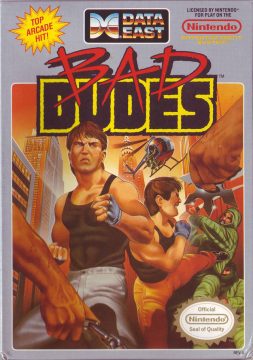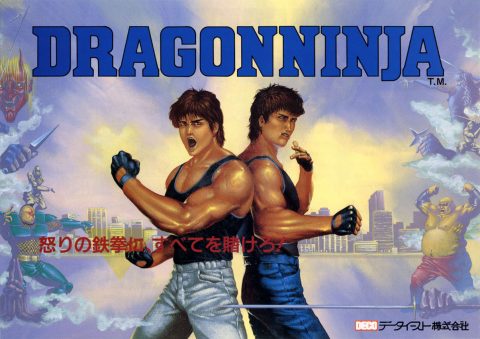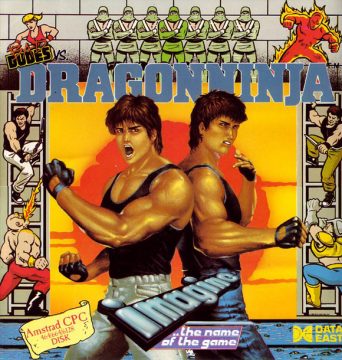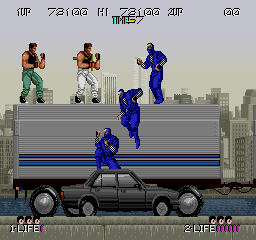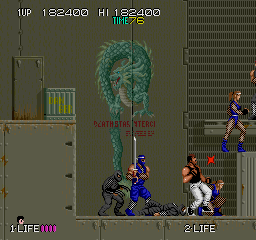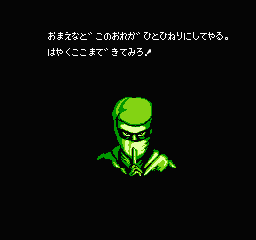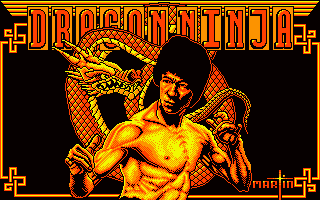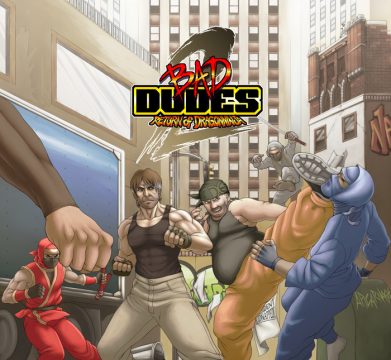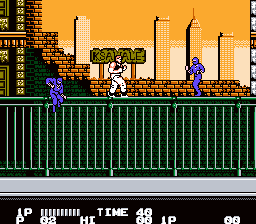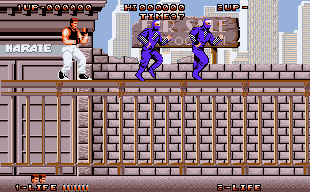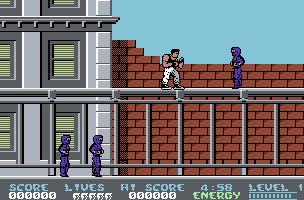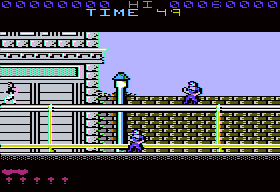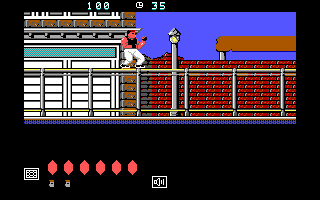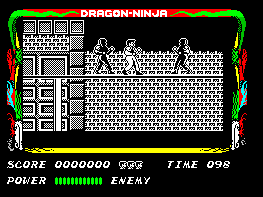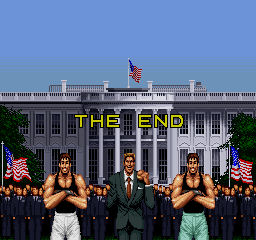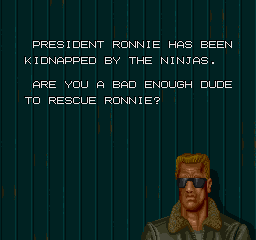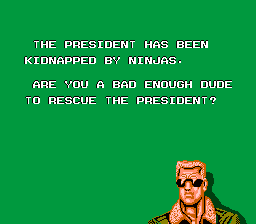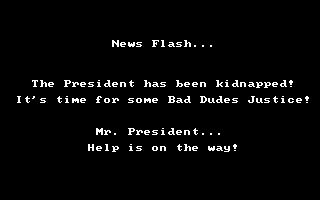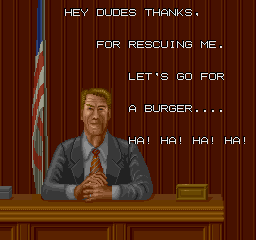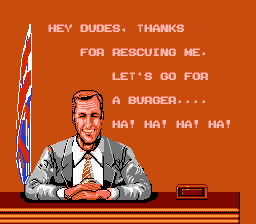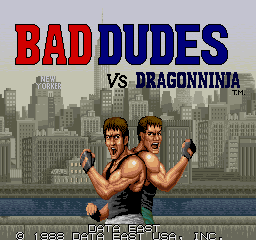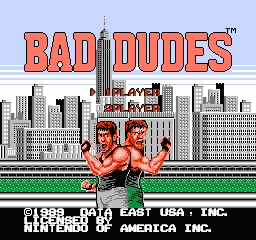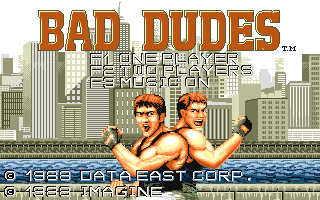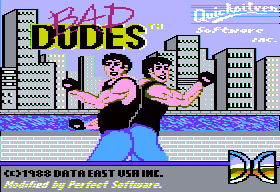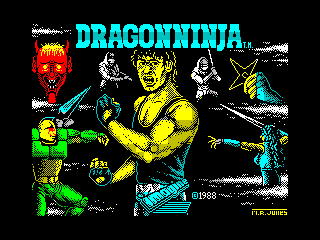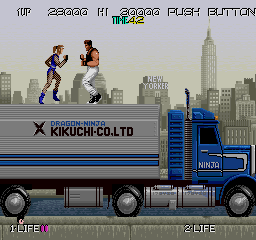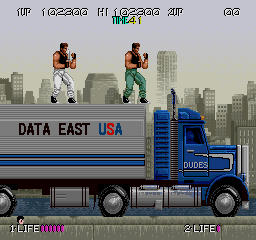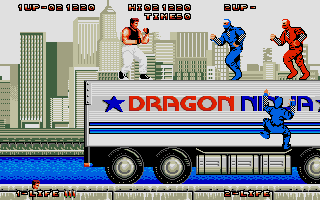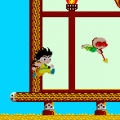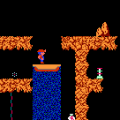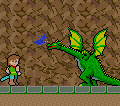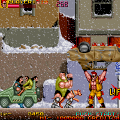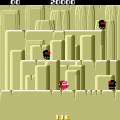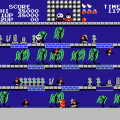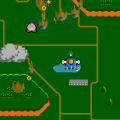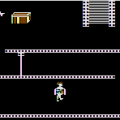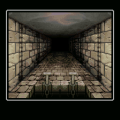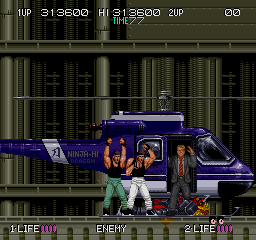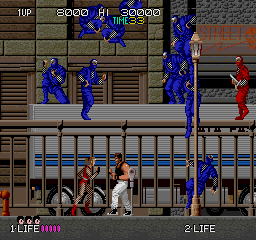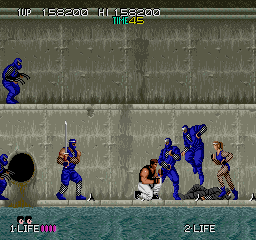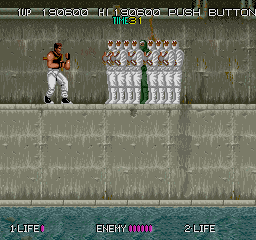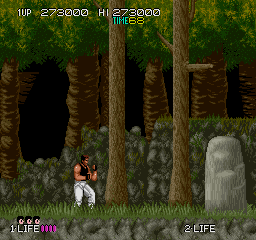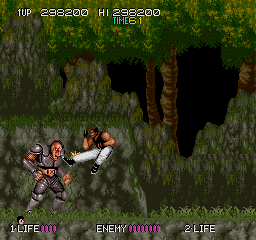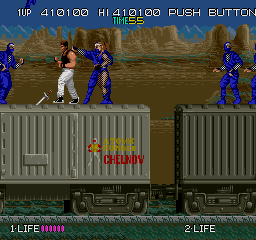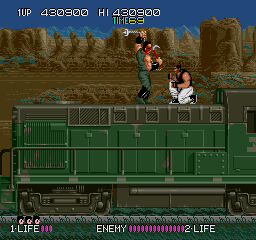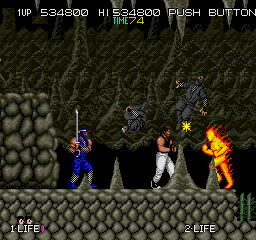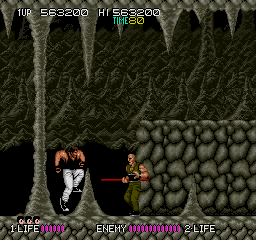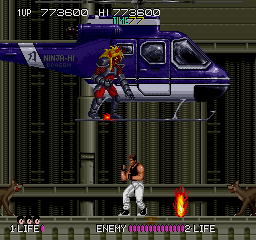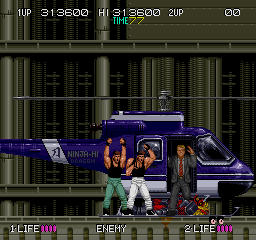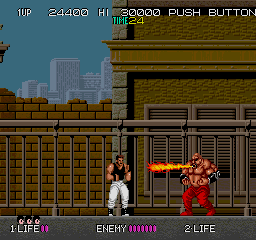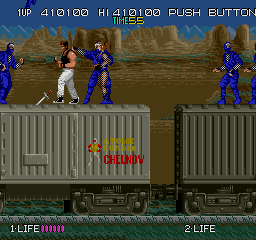In many ways, Data East is the video game equivalent to Cannon Films. Sure, most of their titles are B-grade schlock, but majority of it was too cheesy to hate. The late ’80s and early ’90s could very much be considered Data East’s “Golan-Globus” era of prosperity, taking chances with their spins of more popular genre pinnacles. In the wake of Double Dragon, arcades were flooded with beat-em-ups for every major publisher, and Data East was there muscling for precious machine space. Though their titles didn’t rise far and beyond like Capcom’s or Konami’s, one certain game and its spiritual sequel represent perfect reflections of 80s popcorn action flicks and their badass protagonists in interactive form. It’s pure dumb 2D fighting fun!
Political kidnappings are the subject of many a thriller or drama. Such a threat can be damaging should it be done to such a high profile figure as the U.S. President, and nothing could be more serious an terrorist abductor for a late 80s video game than a clan of ninjas. Fortunately, Blade and Striker, the eponymous “Bad Dudes”, are here to help! This similar-looking duo in black muscle tanks and distinguishing colored track pants are the only ones bad enough to perform this rescue mission.
Unlike most beat-em-ups of the time using an oblique plane perspective to play on, Bad Dudes skews for a flat 2D field with upper and lower portions to leap from much like Rolling Thunder or Shinobi. Depending on your position, your sleeveless avatar will throw a punch or a kick when you press the attack button. Their reach is rather short, but thanks to the Inverse Ninja Law, most of the onslaught of the shrouded enemy masses will fall from one hit. As usual, jump kicks are easy to pull off and can be turned into spinning kicks with the right button timing. A special charge-up power punch can be performed by holding down the attack button, but it’s hard to keep the charge while moving about and is lost when hit, and isn’t necessary except for some of the bosses. Outside of these moves, there’s little in the way of weapon powerups compared to other similar games, only having certain baddies drop knives or good long range nunchucks. Your powerups include a soda can to replenish energy and a clock to refill time, though there’s hardly a risk of running short of time before dying in this game.
The ninjas you fight come in blue, red, green, or grey garb, though there isn’t much of a strength difference between them. Aside from running in to punch you, some ninjas throw shurikens or caltrops at you, slice at you with claws, or wield katanas and do jumping stabs at you. A few female kunoichi are thrown in, able to perform the occasional flip otherwise as the same run-in ninja enemy. The only other baddies are attack dogs and the rare ninja that lights himself on fire and bum rush you. Though the enemies come in droves, there’s no stopping you from just evading them: Unlike most beat-em-ups, the stages don’t halt your progress to defeat each swarm of enemies, so you can rush by avoiding enemies as much as you want – if you can survive pushing through. Make no mistake, this game is a quarter muncher, barely giving you a brief moment of invincibility after being hit. This is a bother from the normal ninja baddies, but a huge risk to take into account with the bosses. All the bosses have a lot more health than you and are dangerous to even approach, leading to many cheap hits trying to land a hit on them.
The game is seven stages in total, with two of them being automatic scrolling levels on large transport vehicles. The first level takes place in a city, starting on top of a stage-wide fence leading to a cameo boss battle with Karnov, Data East’s quasi-mascot. Karnov himself has his signature fire breath attack, but is easy to pin in a corner and kick away. A darker, weaker form of Karnov shows up in later levels as a rare enemy. The second level is on an 18-wheeler with ninjas hopping on from cars driving by before stopping to battle an armored ninja with huge Wolverine claws who loves to block your attacks. The 3rd level sends you slogging through a sewer and dueling with a green ninja who can make ninjitsu copies to swarm you. The 4th level leads you through a forest before challenging a grey bruiser that looks just like the wrestler Road Warrior Animal (his names is even referred to as “Animal” in the Japanese credits). The 5th level has you scrolling left on a train and fighting a ninja wielding a spiked chain weapon. The 6th level takes place in a cave with bamboo traps and falling stalactites and fighting a tall bald bo-staff master monk. The final stage is inside the warehouse base of operations, where you have to make it through a boss rush before coming face-to-face with the Dragon Ninja himself, who fights you while riding on a helicopter and raining fire bombs down on you. On a whole, most of these stages are fairly short, so you’ll spend most of your time (and quarters) dealing with all the tough bosses.
As most beat-em-ups go, Bad Dudes is pretty average, running quickly into monotony by the 3rd or 4th stage thanks to its bland level design and lack of variety in bad guys to fight. Even the cheap thrill of single-handedly one punch KOing legions of ninjas wears thin as the game merely throws more and more at you at once. Yet it does have a simple charm, making it a cult favorite for many and keeps players to pop in a token or two. Data East added in some nice little touches here and there, leaving little graffiti in the street, sewer, and hideout levels. Moai statues can be seen in the southwestern backdrop of the Train stage. They even have the logo for Karnov over one of the street cafes and snuck a Chelnov cameo art on one of the containers on the train. The game is also littered with nice punchy chop-socky sound effects with each hit, with lots of satisfying grunts and oofs. Not to mention the unabashed cheesiness with the serious secret agent asking you “Are you a bad enough dude to rescue Ronnie?” and having a burger with the president himself at the end.
The Japanese arcade release is almost the same as the US and international versions. The cola can health power-ups are blue instead of red (Pepsi instead of Coke?) and the audio samples that Blade and Striker say are different. Grabbing an item has the player say “OK” instead of “Got it!”, and they shout a generic “Ohh!” yell instead of proclaiming “I’m bad!” The logo on the side of the truck reads “KIKUCHI-CO, LTD”, referencing director Makoto Kikuchi. The ending contains the major changes, though. A different song plays instead of “The Star-Spangled Banner,” and President Ronnie erects a statue in your honor rather than go out for burgers with you. The Japanese ending also shows all the enemies except the green multiplying boss ninja. All the staff members have little icons next to their names, including Robocop, Mickey Mouse, and a Dragon Quest slime.
Bad Dudes had a ton of ports made for it, most of them for home computers, but possibly the most well-known is the version made for the NES. It has a 2 player mode, but it’s alternating and not simultaneous, and both players can choose the same dude on the selection screen. Outside of their name and colors, there really isn’t any difference, anyway. The graphics and sound are toned down, with smaller character and enemy sprites, but they do the game justice. The dudes emit a well compressed “I’m bad!” at the end of each level, and the music for the truck and train stages does a nice arpeggio effect. The only real problem is the very slow downward vertical scrolling done as a transition between parts of the stages that can be hard to trigger. Oddly, the controls for the US and Euro versions swap the usual A = Jump and B = Attack layout that almost all NES games had.
There aren’t as many baddies to fight and surround you as in the arcade, but they take more hits than usual to go down (Inverse Ninja Law in effect). You’re also sent back to the beginning of the stage should you lose your 3 lives, and you’re only given 3 continues. Luckily, there is a cheat code that gives you 63 lives to alleviate that issue. Using a code similar to the Konami code even makes all the enemies die in one or two punches like the arcade version. Since the NES port was released in 1989, the president was changed to the newly sworn-in George H.W. Bush. The Japanese Famicom edition is roughly the same as its international version, keeping the same ending the US version had and the same voice sample, but flips the A & B buttons to the usual control method. It was also given a new title screen and has little intermission screens with the upcoming bosses taunting you after stage 2.
The Commodore 64 port is also fairly remarkably faithful, having its own amazing soundtrack done by Jonathan Dunn. The loading screen shows only one bad dude that looks sorta like Jean-Claude Van Damme. The big issue comes in the actually gameplay. With only one button, it becomes harder to leap up and down the sections of the level or to pull off any special kicks. Each attack also has a delay before it comes out, and the hit detection is hugely in favor of the enemies who can hit you from a range beyond yours and faster than you can counter. There’s also no delay after beating a stage before the next one instantly starts.
The Amstrad CPC version starts off with a nicely recreated but out of place rendition of Bruce Lee on the title screen. Aside from that, the game does a halfway decent job mimicking the arcade game with a lot of big, albeit blocky, characters running around onscreen at once. However, your player moves and attacks far too sluggishly to tackle the onslaught, and there’s even less mercy recovery time than in the arcades, meaning you can be killed in one second from an assault by one ninja if you’re not careful. There’s also no music whatsoever. The ZX Spectrum doesn’t fare any better, running at a pokier pace compared to the Amstrad even with everything in monochrome grey. At the very least, the enemies move as slow and stiff as the player does, who is again hampered with only one button to do all his attacks with. Sadly, the MSX port is directly based off the ZX version, looking exactly the same and not taking any of the benefits possible on the machine.
The Apple II version sports the tiniest sprites of all the ports, and doesn’t scroll any of the screens at all. That said, the controls aren’t too bad, though for some reason the game starts you on the far left facing the opposite direction of the oncoming ninjas. Its DOS counterpart far exceeds it with nicely sized sprites and smooth scrolling. However, it has a strange control scheme where the player automatically continues to walk in the direction you chose until you press another way to halt, making it harder to make small adjustments for the boss battles. The opening message has also been wildly altered.
Of all of the home conversions made back around its original release, the Amiga and Atari ST are by far the most faithful, each built off the same port. The Atari ST version runs slower and has lesser sound quality and only has one level theme, but is able to support the same flood of ninjas as the Amiga and arcade games can. For some reason, all the moves in the Amiga port come out much quicker, like a turbo button is being held. The ending thank you from the president was altered and the Japanese statue ending screen was used, as well. Both titles change the logo on the truck to just Dragon Ninja.
The closest arcade perfect port came in 2010 on the Wii, bundled with many other old arcade games from the 80s and 90s on Data East Arcade Classics. The emulation is mostly spot-on, though the graphics are stretched to fit the screen unless you fiddle with the aspect ratio in the options. The game even has simple achievement-based unlockables where you can listen to the music, look at an art gallery or play on a harder setting.
Work on a proposed sequel to Bad Dudes cropped up in 2012 from developer Pinstripe Games, who had intended to obtain the license from G-Mode, who held Data East’s IPs. Bad Dudes 2 would’ve taken place more than 20 years after the events of the first game, with an aging Blade and out-of-shape Striker once again called on to rescue the President (presumably Obama) again. The game would’ve had featured online co-op on PCs and consoles. The title received a Kickstarter campaign on July 9, 2012, but ultimately fell far short of its $80,000 goal.
Screenshot Comparisons
